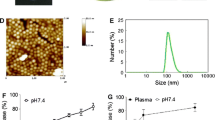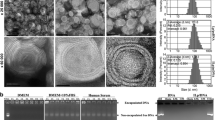Abstract
Vasculature is essential for the sustained growth of solid tumors and metastases. Tumor cells surviving vascular-disruptive therapeutic intervention (especially those present at the tumor rim) can contribute to tumor regrowth. The aim was to strengthen, by carrier-mediated delivery of a chemotherapeutic, the curative effects of a bifunctional anti-vascular oligopeptide capable of inducing vascular shutdown and tumor shrinkage. For the in vitro experiments and animal therapy, ACDCRGDCFC-GG-D(KLAKLAK)2 peptide (900 μM in D-PBSA, i.e. Dulbecco’s PBS without Ca2+ and Mg2+) and size-calibrated, passively or actively targeted liposomes based on distearoylphosphatidylcholine, cholesterol, and N-carbamoyl-methoxypolyethyleneglycol coupled to distearoylphosphatidylethanolamine (PEG–DSPE) and containing gradient-entrapped doxorubicin were used. The KB (human nasopharyngeal carcinoma) cell line overexpressing folate receptors was used in the fluorescence studies of liposomal uptake. The B16-F10 melanoma cell line was used for confirming, by flow cytometry and confocal microscopy, doxorubicin intracellular transfer as well as to induce experimental tumors in C57BL/6 mice. Animal therapy was achieved with injections of vascular-disrupting peptide, doxorubicin-loaded liposomes, or alternating combined therapy. The results (tumor growth inhibition and survival) were compared using the Mann–Whitney U test and the log-rank test. Necrosis in H&E-stained tumor sections was assessed microscopically by pathologists. Treatment of C57BL/6 mice bearing B16-F10 experimental tumors with a combination of vascular-disruptive peptide and doxorubicin-carrying pegylated liposomes (either passively targeted liposomes (PTL) or folate receptor targeted) gave better therapeutic effects when tumor development was re-challenged with a second cycle of combined therapy. Marked inhibition of tumor growth and a statistically significant extension of the lifespan of the treated mice were observed when the re-challenge involved the use of folate receptor-targeted liposomes (FTL). Anticancer therapy involving vascular-disruptive peptide and doxorubicin delivered via pegylated folate receptor-targeted liposomes is more effective than either monotherapy, especially when tumor growth is re-challenged with the therapeutic combination.





Similar content being viewed by others
References
Abraham SA, Waterhouse DN, Mayer LD et al (2005) The liposomal formulation of doxorubicin. Methods Enzymol 391:71–97
Allen TM (2002) Ligand-targeted therapeutics in anticancer therapy. Nat Rev Cancer 2:750–763
Arap W, Pasqualini R, Ruoslahti E (1998) Cancer treatment by targeted drug delivery to tumor vasculature in a mouse model. Science 279:377–380
Banciu M, Schiffelers RM, Storm G (2008) Investigation into the role of tumor-associated macrophages in the antitumor activity of doxil. Pharm Res 25:1948–1955
Bartlett GR (1959) Phosphorus assay in column chromatography. J Biol Chem 234:466–468
Browder T, Butterfield CE, Kräling BM et al (2000) Antiangiogenic scheduling of chemotherapy improves efficacy against experimental drug-resistant cancer. Cancer Res 60:878–1886
Denekamp J (1984) Vascular endothelium as the vulnerable element in tumours. Acta Radiol Oncol 23:217–225
Denekamp J (1993) Angiogenesis, neovascular proliferation and vascular pathophysiology as targets for cancer therapy. Br J Radiol 66:181–196
Dickson PV, Hamner JB, Sims TL et al (2007) Bevacizumab-induced transient remodeling of the vasculature in neuroblastoma xenografts results in improved delivery and efficacy of systemically administered chemotherapy. Clin Cancer Res 13:3942–3950
Eliaz RE, Szoka FC Jr (2001) Liposome-encapsulated doxorubicin targeted to CD44: a strategy to kill CD44-overexpressing tumor cells. Cancer Res 61:2592–2601
Ellerby HM, Arap W, Ellerby LM et al (1999) Anti-cancer activity of targeted pro-apoptotic peptides. Nat Med 5:1032–1038
Folkman J (1990) What is the evidence that tumours are angiogenesis dependent? J Natl Cancer Inst 82:4–6
Folkman J (1996) New perspectives in clinical oncology from angiogenesis research. Eur J Cancer 32A:2534–2539
Gabizon A, Horowitz AT, Goren D et al (1999) Targeting folate receptor with folate linked to extremities of poly(ethylene glycol)-grafted liposomes: in vitro studies. Bioconjug Chem 10:289–298
Gabizon A, Tzemach D, Mark L, Bronstein M, Horowitz AT (2002) Dose dependency of pharmacokinetics and therapeutic efficacy of pegylated liposomal doxorubicin (DOXIL) in murine models. J Drug Target 10:539–548
Gabizon A, Isacson R, Rosengarten O et al (2008) An open-label study to evaluate dose and cycle dependence of the pharmacokinetics of pegylated liposomal doxorubicin. Cancer Chemother Pharmacol 61:695–702
Goren D, Horowitz AT, Tzemach D et al (2000) Nuclear delivery of doxorubicin via folate-targeted liposomes with bypass of multidrug-resistance efflux pump. Clin Cancer Res 6:1947–1957
Hood JD, Cheresh DA (2002) Role of integrins in cell invasion and migration. Nat Rev Cancer 2:91–100
Horsman MR, Siemann DW (2006) Pathophysiologic effects of vascular-targeting agents and the implications for combination with conventional therapies. Cancer Res 66:11520–11539
Huwyler J, Drewe J, Krähenbühl S (2008) Tumor targeting using liposomal antineoplastic drugs. Int J Nanomedicine 3:21–29
Kerbel RS (2000) Tumor angiogenesis: past, present and the new future. Carcinogenesis 21:505–515
Kerbel RS (2001) Clinical trials of antiangiogenic drugs: opportunities, problems, and assessment of initial results. J Clin Oncol 19(18 suppl):45S–49S
Kerbel R, Folkman J (2002) Clinical translation of angiogenesis inhibitors. Nat Rev Cancer 2:727–739
Lee RJ, Low PS (1994) Delivery of liposomes into cultured KB cells via folate receptor-mediated endocytosis. J Biol Chem 269:3198–3204
Lee RJ, Low PS (1995) Folate-mediated tumor cell targeting of liposome-entrapped doxorubicin in vitro. Biochim Biophys Acta 1233:134–144
Levine AM, Tulpule A, Espina B et al (2004) Liposome-encapsulated doxorubicin in combination with standard agents (cyclophosphamide, vincristine, prednisone) in patients with newly diagnosed AIDS-related non-Hodgkin’s lymphoma: results of therapy and correlates of response. J Clin Oncol 22:2662–2670
Lu WL, Qi XR, Zhang Q et al (2004) A pegylated liposomal platform: pharmacokinetics, pharmacodynamics, and toxicity in mice using doxorubicin as a model drug. J Pharmacol Sci 95:381–389
Ma J, Waxman DJ (2009) Dominant effect of antiangiogenesis in combination therapy involving cyclophosphamide and axitinib. Clin Cancer Res 15:578–588
Madden TD, Harrigan PR, Tai LC et al (1990) The accumulation of drugs within large unilamellar vesicles exhibiting a proton gradient: a survey. Chem Phys Lipids 53:37–46
Maeda H (2001) The enhanced permeability and retention (EPR) effect in tumor vasculature: the key role of tumor-selective macromolecular drug targeting. Adv Enzyme Regul 41:189–207
Mitrus I, Delić K, Wróbel N et al (2006) Combination of IL-12 gene therapy and CTX chemotherapy inhibits growth of primary B16(F10) melanoma tumors in mice. Acta Biochim Pol 53:357–360
Motzer RJ, Hutson TE, Tomczak P et al (2007) Sunitinib versus interferon alfa in metastatic renal-cell carcinoma. N Engl J Med 356:115–124
Scappaticci FA (2002) Mechanisms and future directions for angiogenesis-based cancer therapies. J Clin Oncol 20:3906–3927
Sharma US, Sharma A, Chau RI et al (1997) Liposome-mediated therapy of intracranial brain tumors in a rat model. Pharm Res 14:992–998
Siemann DW, Rojiani AM (2005) The vascular disrupting agent ZD6126 shows increased tumor efficacy and enhanced radiation response in large, advanced tumors. Int J Radiat Oncol Biol Phys 62:846–853
Siemann DW, Chaplin DJ, Horsman MR (2004) Vascular-targeting therapies for treatment of malignant disease. Cancer 100:2491–2499
Smolarczyk R, Cichoń T, Graja K et al (2006) Antitumor effect of RGD-4C-GG-D(KLAKLAK)2 peptide in mouse B16(F10) melanoma model. Acta Biochim Pol 53:801–805
Soloman R, Gabizon AA (2008) Clinical pharmacology of liposomal anthracyclines: focus on pegylated liposomal doxorubicin. Clin Lymphoma Myeloma 8:21–32
Szala S (2004) Two-domain vascular disruptive agents in cancer therapy. Curr Cancer Drug Targets 4:501–509
Thorpe PE (2004) Vascular targeting agents as cancer therapeutics. Clin Cancer Res 10:415–427
Tozer GM, Kanthou C, Parkins C et al (2002) The biology of the combretastatins as tumour vascular targeting agents. Int J Exp Pathol 83:21–38
Verheul HM, Voest EE, Schlingemann RO (2004) Are tumours angiogenesis-dependent? J Pathol 202:5–13
Zhou R, Mazurchuk R, Straubinger RM (2002) Antivasculature effects of doxorubicin-containing liposomes in an intracranial rat brain tumor model. Cancer Res 62:2561–2566
Acknowledgments
This study was supported by the Ministry of Science and Higher Education (Grant No. 2 P05A 074 28 and Commissioned Grant No. PBZ-KBN-091/P05/2003), Poland.
Author information
Authors and Affiliations
Corresponding author
About this article
Cite this article
Sochanik, A., Mitrus, I., Smolarczyk, R. et al. Experimental Anticancer Therapy with Vascular-disruptive Peptide and Liposome-entrapped Chemotherapeutic Agent. Arch. Immunol. Ther. Exp. 58, 235–245 (2010). https://doi.org/10.1007/s00005-010-0077-y
Received:
Accepted:
Published:
Issue Date:
DOI: https://doi.org/10.1007/s00005-010-0077-y




